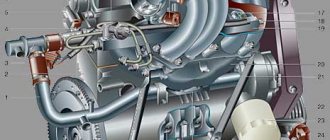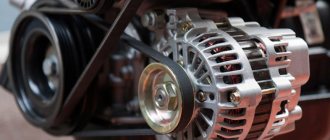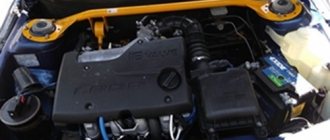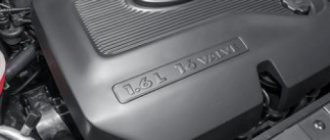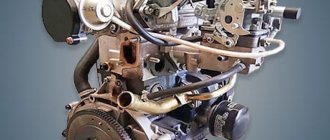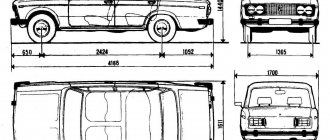Most VAZ models do not have high speed and power characteristics. They are excellent for daily driving: low consumption, good reliability of units, high maintainability. However, due to the enormous popularity of the cars, many drivers are wondering what kind of acceleration to 100 VAZ 2114 is. in different years of production, several types of engines were installed on the car, each of them producing different performance indicators. Let's look at overclocking each of the 4's variations.
Useful video:
Differences between VAZ 2114 and VAZ 2109
The improvements of the VAZ 2114 in comparison with the prototype turned out to be more than serious. They affected both the appearance and the technical part of the car.
2114 designers made a number of changes:
- new front and rear bumpers installed;
- updated version of the hood;
- the model received improved optics;
- the radiator was lined;
- added a package of moldings.
The interior of the car has changed even more. The instrument panel and steering wheel were completely replaced. To improve passenger and driver comfort, engineers replaced the outdated heater. The 2114 also received new front windshield wipers.
Read more about testing in different weather conditions
On snow-covered city streets, you should pay more attention to sharp or dynamic maneuvers, namely acceleration and braking, since the car constantly strives to deviate from the intended course.
For the sake of fairness, it is worth noting that it does not come to dangerous situations: as soon as the car changes its trajectory, electronic assistants (ESP or ABS) are activated.
The dynamic stabilization system prevents slipping of the drive wheels, albeit with some delay, as does the anti-lock braking system, which allows the wheels to lock, albeit briefly.
Lada Kalina 2 is equipped with ESP and ABS
On a track covered with snow and ice, it becomes much more “fun”: you have to take into account not only the delayed response of the electric booster to the turning angle, but also the slipping of the tires. As a result, any lane change turns into an attraction to maintain optimal balance, since the steering wheel cannot be left motionless even for a moment.
Engine VAZ 2114
The most anticipated changes to the VAZ 2109 concerned the power plant. In the first generation, the model used an 8-valve engine 2114. It had a displacement of 1.5 liters. In the next update of the VAZ 2114, which occurred in 2007, this engine was replaced with an improved one with a volume of 1.6 liters.
The installation of a 16-valve engine on the VAZ 2114 was a real breakthrough for the model. This modernization was carried out entirely under the control of Super-Avto CJSC, part of AvtoVAZ OJSC. The most important characteristic of the 16 valve VAZ 2114 is the maximum power of 89 hp. Thus, the car is technically very close to foreign-made budget cars.
For comparison, we suggest you consider the following table of dynamic indicators:
| LADA 2114 8V | LADA 2114 16V | |
| Maximum power, kW/rpm/hp | 59,5/5200/81 | 66/5000/89 |
| Maximum torque, Nm at rpm | 120/2700 | 131/3700 |
| Fuel consumption in mixed mode, l/100km | 7,6 | 7,0 |
| Maximum speed, km/h | 160 | 190 |
| Acceleration to 100 km/h, s | 13,2 | 11,2 |
What makes sports cars start quickly?
The car behaves confidently on the road.
In order to start quickly, the car must be light. For example, Lada Priora, a sports hatchback, has a curb weight of 1088 kg and almost all parts of its body are made of galvanized or stainless steel. In global production, to reduce fuel consumption and increase the speed characteristics of sports cars, bodies are made on the basis of aluminum frames using composite materials and carbon fiber (40% lighter than metal), which allows, for example, the Hennessy Venom GT model to accelerate to 100 km/h. in two point seven seconds.
Of course, such fantastic acceleration occurs on supercars due to the fact that they have an engine of a different order than the Lada Priora. The same “Hennessy Venom” has 1244 horsepower under the hood and a volume of 6.2 liters versus ninety-eight “horses” of the Priora family. That is, the difference is more than 10 times, despite the fact that Venom weighs only 180 kg more and costs 100 times more than a product from the domestic automobile industry.
However, even for cars with the same engine displacement, acceleration to 100 can be achieved in different times. Sometimes even a Lada Priora can run faster than a more powerful model, which “wake up” only when the tachometer (determines the number of revolutions of the rotating parts of the car, its engine) approaches the middle of the scale. And the point here is the different elasticity of the engine, which is expressed in different torque characteristics.
Torque, as we know from school physics, is the product of the force applied to the lever and the length of the lever itself. In the Priora, like in other cars, torque occurs when the mixture of air and fuel, after pressing the gas pedal, burns in the chamber, and the vapors expand and press on the piston. Then the connecting rod mechanism translates the reciprocating movements into revolutions of the crankshaft - this is how rotation appears, realizing torque.
This vector physical quantity can be different at different speeds, and is involved in creating the traction force, which moves the Lada car when the traction overcomes the force of the car’s own gravity, air resistance, etc.
Road characteristics of the VAZ 2114
In addition to the fact that a 16-valve engine was installed on the model, the VAZ 2114 was significantly re-equipped to improve road properties. The car's gearbox with a gear ratio of 3.7 received a new package of “closed” bearings, which significantly increased the reliability and performance of the system, in particular the torque of the car.
For the braking system of the 16-valve VAZ 2114, engineers used larger diameter (up to 200) clutch brake discs than in 2109. In addition, the brake cooling system was improved, which made it possible to achieve not only safety, but also reliability.
The designers managed to achieve great success in terms of vehicle stability. This was mainly possible thanks to the installation of high-energy shock absorbers, as well as struts from the 2107 model. This set of procedures led to increased body rigidity, road stability, maneuverability and durability.
On-board computer for VAZ 2107 injector
Video tutorial on installing an on-board computer in a VAZ 2107
The device is fully compatible with January controllers versions from 5.1 to January 7.2, as well as Itelma, Avtelm 73 under Euro3, but is not intended to work with Bosch controllers, which are installed on nines. Therefore, the State 2107×1 works only with an injection seven engine. The device is quite easy to understand. It only has two buttons and three numbers. As a plug, you can't think of a better one. But besides this, the device has as many as 30 functions. It makes sense to dwell on some of the most useful ones in more detail.
Reviews of VAZ 2114
Reviews about the 16 valve VAZ 2114 can be said to be mostly positive. In comparison with the 8-valve version, drivers highlight:
- Reduced fuel consumption;
- Increased power;
- Improved overall dynamics.
On the other hand, let's not hide it and look at the weaknesses of the car. As you know, the 16 valve model never entered mass production, and this led to several negative factors at once.
- Firstly, it is not always possible to obtain good quality assembly, which is carried out at Super-Avto CJSC.
- Secondly, the car is expensive to repair, as some spare parts are difficult to obtain.
On-site testing
The final stage of testing is exercises on the site. The maximum value of lateral acceleration that was achieved under the desperate sounds made by Chinese tires was 0.84 g. At the same time, the car tries to fall into an uncontrolled skid, and when the gas is released, the Lada returns to the given trajectory without much difficulty.
Maximum lateral acceleration value
The electric power steering, or rather, its shortcomings, again reminded itself when performing the “snake” exercise. This time the cause of the problem was too much effort, which is not easy for even men to cope with, let alone women. It is unlikely that a fragile girl will be able to quickly perform a counter-emergency maneuver with such EUR settings.
In the end, the only thing that really pleases is the noticeable progress of VAZ. Be that as it may, the second generation Lada Kalina is no longer the usual “Zhiguli”, although this car still requires significant improvements. Of course, many car enthusiasts would like to see more significant progress, but in this case they should be patient. Domestic manufacturers have something to strive for, and the fact that they are trying to improve their lineup speaks volumes.
What engines drive the VAZ-2114
"VAZ-2114" was produced from 2001 to 2013. Until 2007, it was equipped with a 1.5 77 hp engine. With. It easily lasted 200 thousand km, but was disappointing with noise, knocking and thermostat failure. In the 2007 models, a 1.6 engine with 81 hp appeared. With. It has more torque, but makes noise like a diesel engine.
Both versions work with a five-speed manual transmission. Sometimes there are cars with a 16-valve 1.6 engine with a capacity of 90 or 98 hp. With. It is one of the best from AvtoVAZ, especially for those who like to tune and modify the engine.
Tuning an injector with 8 valves
To increase power from 77 to 96 horsepower of the very first engine of the VAZ-2111 model, you need to do:
- boring valve seats along the inner diameter;
- boring the channel necks for installing duralumin plates and loosening the springs by 1.5 millimeters;
- replacing standard valves with lightweight ones;
- recessing of guide bushings from special brass;
- installation of a split timing gear;
- use of imported valve cotters;
- installation of a narrow-phase shaft.
The tuning shaft has an inlet of 70 degrees and an outlet of 66. Its opening angles are 250 and 246 degrees, respectively. After completing the work, it is necessary to install the engineering firmware and carefully configure the motor parameters. Only in this case, after all sensors are turned on, the engine will start working normally.
It is better to use a split gear on non-plug-in motors. For installation, it is necessary to carry out the work in almost the same way as when replacing the timing belt, that is, apply marks, disassemble the mechanism, and align the crankshaft. After installing the new gear, pay attention to the 4th cylinder. If the valves in it are not open to the maximum, in this case you will need to loosen the outer screws and adjust the camshaft, after which you need to tighten the fasteners.
What is the salon equipped with?
The exterior of the VAZ is not for everyone. In order for the car to somehow correspond to the spirit of youth, the manufacturer gave the body sporty features: it rounded the hood, extended the headlights and moldings, and decorated the sill and bumper with body-color trims.
The interior is simple, but corresponds to the era of the early 2000s. The seats can hardly be called comfortable, so many people install an adapter or change the driver's seat. Although there is a Europanel, there is no glove compartment there. The only options available are power windows and an illuminated dashboard.
An unexpected bonus from AvtoVAZ is an adjustable steering column. It will allow you to raise and lower the steering wheel to the desired height to suit the height and build of the driver.
The trunk of the “fourteenth”, like the glove compartment of a jeep, is 330 liters. This will include a suitcase and a couple of bags from the supermarket. With the rear seats folded down, cargo space nearly doubles.
How does the VAZ 21074 injector control circuit work?
VAZ 21074 with an injection type engine has its own characteristics. Firstly, there is electronic control of the engine. This system clearly controls the composition of the fuel mixture. The fuel pump is also controlled and turned on and off electronically. This control is exercised over all parts of the engine.
The VAZ 21074 injector circuit consists of the following main components: an electronic unit, several sensors, connecting wires. There is a warning lamp on the dashboard that lights up in the event of malfunctions in the operation of system elements. When the car starts to operate and the engine starts, checking its operation begins. The warning light first turns on and then, if everything is OK, goes out. If the lamp lights up while the car is running, this indicates possible malfunctions in the engine.
Pros and cons of the “four”
Owners about the peppy engine. Acceleration dynamics are 17 seconds/100 km, which is not bad at all for domestic cars. Fuel consumption is 7 liters per 100 km in city mode and 5 liters on the highway.
The ground clearance is not bad - 16.5 cm. The car is adapted to “killed” roads and goes well in the snow. The suspension is strong and rarely breaks. But when hitting a hill, the front suspension extension fasteners may be damaged. The reason is the fragility of the aluminum “crab”.
Gearbox synchronizers wear out quickly. To avoid buying a car with such a breakdown, move the shift lever during the inspection. If you hear extraneous sounds, there is something wrong with the synchronizers.
Due to the softness of the metal, dents and mechanical damage easily appear on the body. The metal is not galvanized, so rust is a natural phenomenon for the “four”. Spots appear in the contours of the arches, sills, places where the bumper and moldings join the body. The quality of the paintwork is average and prone to chipping.
And the saddest thing about the car is the lack of passive (not to mention active) safety features. There are no airbags or seat belt pretensioners in the cabin. If the car collides with an obstacle, passengers may receive injuries of varying severity: from bruised shins to fractures of the chest and cervical vertebrae.
Car parts are relatively inexpensive. The bumper can be bought for 3,500 rubles, the hood for 7,500 rubles, and the engine is estimated at 10 thousand rubles. For comparison, for a new bumper of the popular Lacetti in Russia they are asking 5,000 rubles, for the hood - 8-12 thousand rubles, for the engine - 30-60 thousand rubles.
The main mistakes made when tuning
Many people try to add power to the engine, but at the same time make typical mistakes. The leading ones among them are:
- installation of cutters in garage conditions (this work requires high precision);
- use of unnecessary and expensive spare parts;
- lack of suitable firmware for a sports camshaft or other elements.
Before buying expensive spare parts, you should pay attention to the recommendations of the specialists. They created a list of useless components:
- A receiver with an increased volume is good only at medium and high speeds, but for work in the range from 1000 to 2500 rpm, a standard spare part is more preferable.
- A zero filter, called a “chandelier,” is a fairly useful addition, but you will have to constantly clean it with special chemical compounds. This will increase the cost of maintaining the car.
- A throttle valve of increased diameter does not increase power too much, since the engine always has enough air.
What kind of breakdowns will a novice driver encounter?
The driver who bought the “fourteenth” as his first car receives a real simulator for real driving. But the car is Russian, something will always break down in it. Here is what the former owner of the VAZ-2114, Igor Bolshakov from Yekaterinburg, said about the breakdowns:
“I drove a three-year-old “fourteenth” for several years. I bought it in 2010 with a mileage of 58 thousand km. This was my first car, so I didn’t choose alone, but with knowledgeable people. They pointed out to me the rust in the front wheel arches. Therefore, immediately after the purchase, according to the advice, I carried out anti-corrosion treatment, and also changed the oil and installed a spacer.
There were no engine knocks at idle, but the gearbox hummed and the lever vibrated. In winter, antifreeze was quickly used up. I was also surprised by the considerable gas consumption (a tank lasts 250-300 km). There were minor breakdowns: the generator belt broke, the lights needed to be replaced and minor electrical repairs were required.
However, there were also advantages: the car started well in cold weather, there were no complaints about the suspension or engine, the high seating position was pleasing, and, most importantly, the car drove. Overall, there were no big disappointments: I knew what I was buying. But we still had to invest in repairs and maintenance.”
If a novice driver does not have repair skills and money to visit auto repair shops, a broken car may be laid up.
Problems when installing an additional sixth gear
An additional sixth gear will help make the car more obedient.
If you decide to put sixth gear on your Lada Priora yourself in order to accelerate faster to 100 kilometers per hour on the road, then you need to take into account, for example, that in the assembly the gears for 5th and 6th gears on the input shaft will be single whole, additional costs will be required for roller and needle bearings, stabilizer locking rings, retaining rings, studs (possibly M8 size), spacer rings, synchronizer hub for 1-2 gears, etc. In addition to the set of tools usually used for overhauling the Priora gearbox, the car enthusiast You will need a 6-point 12-pointer, a grinder, a locking agent for threaded connections and, perhaps, a drill with a cutter.
To ultimately achieve a faster 0-60 mph time, the car can undergo a number of difficult modifications when installing sixth gear. The Lada Priora gearbox may not allow you to immediately install the fifth gear gear, because there may not be enough space for the needle-shaped bearing (you will have to grind the bearing or spacer ring with a grinder). The bushing may have to be pressed onto the output shaft using a hammer, and the synchronizer hub may be lost.
When installing the sixth gear gear from the secondary shaft on a Lada Priora, you may be faced with the fact that you will have to remove the bearing from the assembly, and when closing the gearbox cover, you may have to grind it down so that it does not touch the raised steel plate. In addition, when we put the gearbox redesigned for “acceleration to 100” back into the car, it may affect the spar, and it will require sawdust or the installation of special engine mounts that make its location lower with the gearbox. Therefore, for a faster start at a traffic light, you need to pay decent money or have high qualifications in order to carry out all the work yourself and without harm to the car.
How much does a used VAZ-2114 cost?
Despite its modest equipment and unpresentable appearance, the VAZ-2114 is very popular in the secondary market. In 2022, it became the best-selling car in Russia, far ahead of the more advanced Focus, Corolla and Solaris.
Now almost 12 thousand copies are available on the secondary market at an average price of 142 thousand rubles. For the earliest ones they ask for an average of 60 thousand rubles. For 55 thousand, I found a copy with a mileage of 125 thousand km:
The “freshest” VAZs, from the 14th year of production, cost an average of 196 thousand rubles. For 175 thousand you can get a model with a mileage of 36 thousand km:
What problems do “14s” have with mileage?
Young people, as a rule, get the most out of their cars, which is why there are a lot of damaged cars on the secondary market. Here is a live example, you don’t even need to look closely:
The avtocod.ru report shows that the car was involved in accidents three times:
In all three cases, the impact fell on the same part of the body:
The car was issued a copy of the title, there are restrictions on registration with the traffic police.
Another problem with used “fourteeners” is the twisted mileage. Here's a live example:
The mileage in the ad is 150 thousand km, in the report it is 146,343 km:
But in fact, the car has driven more than 200 thousand km:
This car is pretty tired and will probably require repairs. Better to look for something else.
Braking test
A series of control braking tests from 100 km/h were carried out on the dry and level concrete surface of the test site. The results range from 36 to 38.5 meters. At least ten attempts were made, and all of them followed the same scenario: pressing the brake pedal - a sharp “nose dive” - the first stage of ABS operation - another “peck” - a complete stop of the car, accompanied by a slight blocking of the wheels.
During the experiments, neither the car's drift from the trajectory nor its skidding were observed. This is also evidenced by the uniformity of the obtained values: slightly higher values are a consequence of tests carried out after the brakes have warmed up. A short break helped correct this shortcoming, which allowed the car to stop again at a mark slightly exceeding 36 meters.
Again, we must not forget that the tests were carried out under normal conditions, so we can only guess about the performance that the car could demonstrate in other situations (for example, wet asphalt or different road surfaces).
Braking measurements were carried out on Linglong summer tires, which the Lada Kalina was equipped with when purchased. Instrumental measurements were also carried out on Toyo winter tires, but it looked less like tests and more like attempts to destroy a new set of tires.


